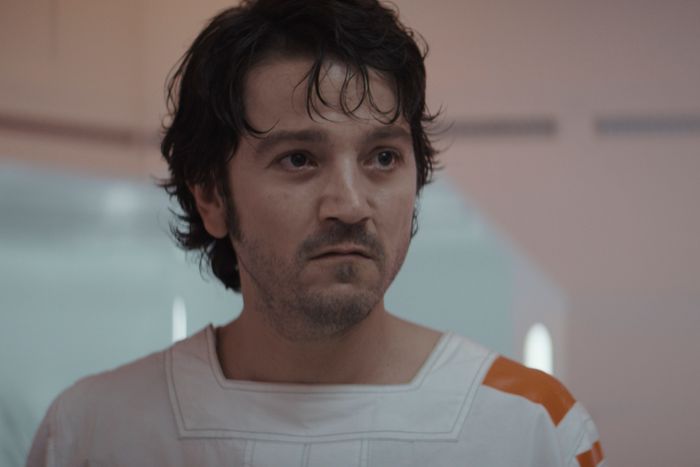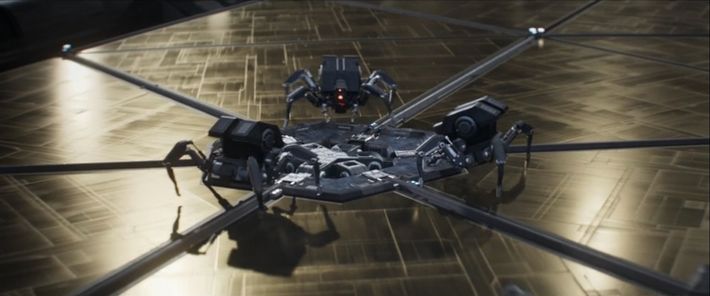
Warning: This story contains spoilers for all of Andor season one, including finale “Rix Road.”
For most of its first season, Andor didn’t feel like a Disney+ show. It was much more serious and less winking than the other Star Wars shows or any of the MCU series, and while there were plenty of Easter eggs strewn about, they always seemed to be organic bits of world-building rather than fan bait. Even so, the season finale ends with something that’s seemingly inevitable in any big genre IP title: a post-credits scene. However, this post-credits scene maintains Andor’s level of restraint and excellence. This isn’t Deep-fake Luke Skywalker emerging from the shadows to invite Cassian Andor to join the Rebel Alliance, Nick Fury–style. Instead, it’s a bit of clarifying information that pays off hunches viewers might have had all season, adding dramatic weight while fundamentally changing nothing for any of the characters in the world of the show.
When Andor’s credits have finished rolling, the action cuts to space, where a couple of droids are installing a familiar-looking contraption. It’s one of the widgets that Cassian, Kino Loy, and the other Narkina 5 inmates were building, shift after shift, during their never-ending sentences. The camera pulls back to reveal that these contraptions are brackets holding together what look like golden solar panels. We pull back farther and farther, and the scale of what we’re dealing with becomes clear. There are countless Narkina 5–made brackets holding together countless panels, all of which become bigger hexagon-shaped panels that in turn make one layer of the concave dish that houses the Death Star’s super-laser. Cassian was building the Death Star.
There are subtle hints throughout the season that the Death Star has been under construction. In episode four, there’s mention of an increase in construction shipments going to Scarif, the planet where Cassian dies while stealing the Death Star plans in Rogue One. There are other lines of dialogue that don’t explicitly allude to the Death Star, but ensure its existence is in the audience’s mind, like when Luthen rhetorically asks Mon Mothma, “Has anyone ever made a weapon that wasn’t used?” There are thematic nods to the Death Star, like Syril gazing at his somewhat Death Star–shaped cereal while his mom reads him for filth. And there are context clues, like the Narkina 5 prisoners saying that, whatever they’re building, the Empire needs it.
The timeline of the Death Star’s conclusion tracks. We see the bare skeleton of the moon-size battle station at the end of Revenge of the Sith, which takes place in 19 BBY. (The Star Wars calendar is divided into before and after the destruction of the Death Star as seen in A New Hope — hence, Before the Battle of Yavin, or BBY.) Season one of Andor takes place in 5 BBY — 14 years after Revenge but a few years before A New Hope and Rogue One, which also takes place in 0 BBY. It would make sense that the Death Star would be near completion and that its sheer size and complexity would require lots of labor and parts.
(One side effect of seeing how long it took to build the Death Star and how many man hours went into its construction? The construction of the second Death Star, which was bigger than the first one but built in less than four years, takes place absurdly fast in comparison. Conditions on Narkina 6 or whatever must have been even worse if they got it built that quickly! That’s not Andor’s problem, though. Take it up with Return of the Jedi.)
While there may be Star Wars fans disappointed by this glimpse of the Death Star without an accompanying cameo from Darth Vader, Orson Krennic, or Galen (or Jyn) Erso, the moment is perfect for Andor. This is not their story. All of those characters are alive and active at this moment in Star Wars history, but Andor didn’t feel the need to loop them in for a gratuitous one-off appearance or as a tease of what’s to come. We saw Rogue One, we saw A New Hope. We know what’s coming. One of Andor’s strengths is how it makes the Star Wars galaxy feel vast and lived-in without relying on reference. To bring in an established character would be a distraction — something that takes audiences out of this story and into another. Whereas showing only the construction of the Death Star further invests the audience in Andor’s story, because it’s filling in a knowledge gap.
What makes the post-credits scene especially good, though, is that it’s only the audience who has that knowledge gap filled in. Cassian has no idea what he was building. He doesn’t know what a “Death Star” is — none of the rebels will until years later when Riz Ahmed’s Bodhi Rook blows the whistle and sets Cassian, Jyn, & Co. out on their mission to steal the plans.
Andor could have gotten away with never revealing what the Narkina 5 prisoners were building. There’s a certain allure to the mystery. They could have been building something more generic, like TIE Fighter parts, or nothing at all — the labor was just a form of torture — and the Narkina 5 arc would still have an impact. Cassian isn’t any more or less changed by the experience for knowing or not knowing what he was building. But thanks to the post-credits scene, the audience, and only the audience, does know that he was building the instrument of his own death.
It’s a perfect bit of dramatic irony that leans into one of the early criticisms of Andor: Everybody knows the ending. It’s exactly because we know the ending that the sight of the Death Star hits like a ton of Ferrix-made bricks. We’re reminded of the stakes as we draw a connection between our protagonist and his inevitable fate — a connection that he’ll never make, nor does he need to.


